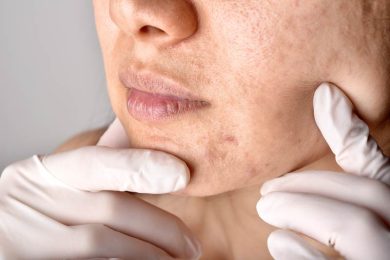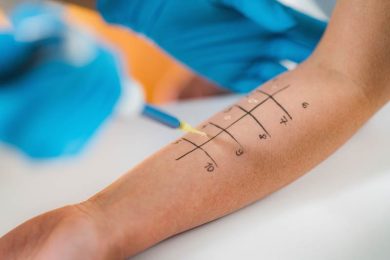Why Is Nasal And Sinus Surgery Performed?
We offer nasal and sinus surgical treatment options for conditions that either require surgery or aren’t responding to other medical or procedural treatment plans. Most of these can be managed or cured using nonsurgical treatments.
In some cases, though, our physicians may recommend surgical solutions. Whether or not you’ll require surgery depends entirely on your individual health and personal needs. Some examples of conditions that may require nasal or sinus surgery include the following:
- Nasal blockage
- Chronic sinusitis
- Deviated septum
- Sinus or nasal trauma
- Nose bleeds
- Nasal polyps
- Enlarged turbinates
- Chronic stuffiness
- Chronic breathing issues

What Nasal & Sinus Surgery Options Are Available?
Depending on your condition, insurance, lifestyle and symptoms, your ENT physician may recommend one or more surgical treatment options. Some of the most common procedures we perform in-house or at our outpatient surgery center include the following:
- Functional endoscopic sinus surgery (FESS) is used to improve nasal drainage and open up the nasal passageways. To perform this outpatient procedure, your doctor uses an endoscope (a small probe with a camera on the end) to enter your sinuses and remove problematic tissues and diseased sinus mucosa.
- Image guided surgery is another endoscopic surgery option for severe forms of chronic sinusitis or nasal blockage that can’t be treated using normal sinus surgery methods. It relies on a three-dimensional mapping system created from CT scans for extreme precision.
- Balloon Sinuplasty uses a small balloon catheter inserted into the sinuses then inflated to open up the nasal passageways. Once the sinuses reach the desired width, the balloon is deflated and removed, leaving more space in the passageway.
- Caldwell Luc operation improves drainage in the maxillary sinus by creating a window from this cavity to the nose. The surgeon enters the maxillary cavity endoscopically through the upper jaw above the molars.
- Septoplasty procedures reshape, reduce, or reposition portions of the septum’s bone or cartilage to open up the nasal passageway and improve drainage and breathing. These procedures are used to reduce blockage, fix a deviated septum, repair a broken nose, and more.
- Turbinate surgery reduces airway obstruction and difficulties breathing caused by enlarged or swollen turbinates, which are small bones that clean and humidify air as it passes through your nose.
- Nasal valve repair using the LATERA implant.
Who is a candidate for the balloon sinuplasty procedure?
If you’re suffering from chronic sinusitis and have exhausted your treatment options, you may be a candidate for Balloon Sinuplasty. This minimally-invasive surgical solution is a safe and effective method of enlarging your sinus passages for easier breathing and a drastic reduction in sinusitis symptoms.
What is sinusitis?
Chronic sinusitis, or sinus infections, is a widespread condition affecting 37 million Americans. This inflammation of the sinuses occurs when the sinus opening becomes blocked, preventing mucus from draining properly. It causes cold-like symptoms that include congestion, runny nose, sore throat, facial pain and swelling, loss of smell or taste, bad breath, fatigue, and headache.
It is most often caused by viral infections, but can also occur as a result of nasal polyps, a deviated septum, or head trauma. Medical solutions work for some, but for others who continue to suffer despite numerous attempts using a variety of treatments, balloon sinuplasty may be the answer.
How is balloon sinuplasty performed?
Balloon sinuplasty is typically performed in an outpatient setting. You’ll be given either a local or general anesthetic before a balloon catheter is inserted into your sinus cavity. The balloon is then inflated in order to enlarge the sinus opening and widen the walls of the nasal passages.
A saline solution is sprayed into the cavity to flush out mucus and other debris; the catheter is then removed. The end result is open sinuses that enable normal breathing and drainage of fluids. Up to 95 percent of patients report a significant improvement in sinus symptoms following this procedure.
What is different about the balloon sinuplasty procedure?
Conventional sinus surgical procedures involve cutting and excision of bone and tissue, a process that may require a lengthy recovery period.
In comparison, balloon sinuplasty is quick and relatively painless and has a lower risk of complications or side effects. It is FDA-approved and considered a safe alternative to endoscopic sinus surgery.
Is balloon sinuplasty effective?
What is recovery from balloon sinuplasty like?
Post-procedure, patients may feel tiredness, grogginess, and congestion for up to a week. Avoid blowing your nose for a few days after the procedure and strenuous activities.
Patients can return home a few hours after surgery, and most patients can get back to their typical activities within just a couple of days.
What is endoscopic sinus surgery?
Why is endoscopic sinus surgery performed?
How is endoscopic sinus surgery performed?
Endoscopic sinus surgery is a minimally invasive procedure intended to widen drainage passages of the sinuses without incisions. The objective of the endoscopic technique is to minimize downtime and tissue trauma while alleviating the symptoms of chronic sinusitis. When the sinuses have narrow drainage pathways, caused by inflammation or other factors, the sinus cavities do not drain as they should.
The endoscopic sinus surgery process involves the use of a small fiber-optic telescope. This tiny tube-like instrument can access the sinus cavities through the nostrils and remove mucus membranes or protrusions that are inhibiting proper drainage.
What should I expect with endoscopic sinus surgery?
Most endoscopic sinus surgeries are performed as outpatient procedures using general or local anesthesia, and the surgery typically takes between 1-3 hours. Patients may stay at the facility to recover for an hour or so after the procedure.
Post-procedure, patients can expect minor bleeding from the nose for 1-2 days. The nose may be packed to help prevent this or keep it to a minimum. It is common for patients to feel more fatigued than normal for up to two weeks after endoscopic sinus surgery. Congestion is also a common sensation that should resolve in one to two weeks.
Patients will receive detailed postoperative instructions before their procedure. Please review the details beforehand and adhere to the instructions provided.
For questions or concerns about the procedure or post-op care, please contact our office.




















